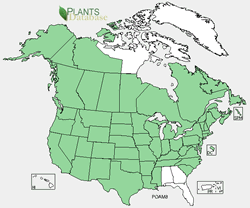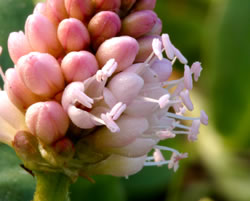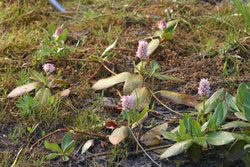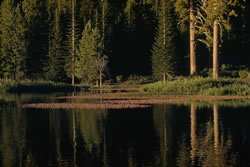Plant of the Week
 Polygonum amphibium range map. USDA PLANTS Database.
Polygonum amphibium range map. USDA PLANTS Database.
 Close-up of the inflorescence of Polygonum amphibium. Photo by Gary Monroe.
Close-up of the inflorescence of Polygonum amphibium. Photo by Gary Monroe.
 Close-up of floret showing anthers and stigma of Polygonum amphibium. Photo by Steve Matson.
Close-up of floret showing anthers and stigma of Polygonum amphibium. Photo by Steve Matson.
 Polygonum amphibium in habit on wet soil. Photo by Steve Matson.
Polygonum amphibium in habit on wet soil. Photo by Steve Matson.
 A large floating mat of Polygonum amphibium. Photo by Charles Weber, California Academy of Sciences.
A large floating mat of Polygonum amphibium. Photo by Charles Weber, California Academy of Sciences.
Water Smartweed (Polygonum amphibium)
By Walter Fertig
Plants that occur in wetland habitats typically specialize in either growing on waterlogged but not flooded muddy soils, or in the water itself (either submerged or floating on the surface). Relatively few plants are able to grow under both conditions. One such species is the Water smartweed (Polygonum amphibium), which true to its Latin epithet, is an amphibious plant. It has been quite successful, naturally colonizing much of North America, Europe, and northern Asia and has been introduced to Mexico, South America, and southern Africa.
Thick spikes of bright pink flowers borne on a thick, naked stalk above the alternate, oval, leathery green leaves characterizes water smartweed. When growing on land, the stems are erect to decumbent and densely pubescent (as are the leaves) and the leaf blades have sharp-pointed tips. Plants growing underwater have glabrous (hairless) stems, leaves, and blunt-tipped leaf blades. In the past, these two different growth forms were described as separate species, though research has shown that the extreme variability between forms is dampened by a nearly continuous set of morphologically intermediate plants.
Polygonum is a large and variable genus of 65-250 species, depending on how taxonomists define the genus. In recent years, taxonomists have been splitting the group into smaller, more natural segregate genera. Water smartweed belongs to one such segregate genus, Persicaria, along with 100 other Polygonum species with spike-like flower clusters. The genus name Persicaria comes from the resemblance of the leaves of many species to those of Peaches (Persica in Latin).
Water smartweeds have a long history of human use. Several Plains Indian tribes used the species as a food source, while other groups derived medicines from the roots, stems, and leaves. The term smartweed is thought to be a more sanitized version of the original word “arsmart” for the use of the plant in medieval times to relieve itching and swelling of the human posterior. More recently, scientists in England have found that Water smartweeds growing in old gold mine tailings can accumulate trace amounts of gold into their tissues at levels significantly higher than expected from background levels. Some have suggested the plant could be used as a bioassay of useful minerals or to clean up badly polluted sites.

